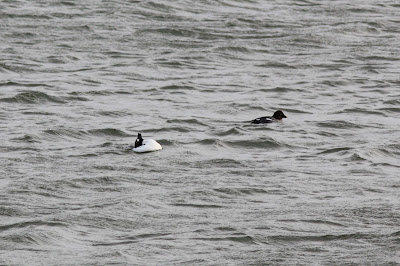 |
| View looking north across bund |
 |
| View looking south across bund. Photo courtesy of The Admiral |
The irony of the situation is that after this river valley site was worked for gravel extraction, it became a wildfowl sanctuary in 1970. A twenty year research project was then undertaken by the site owner, Amey Roadstone Construction (ARC) and the Game Conservancy. In 1992, the results of this project were published in 'Wildlife After Gravel' by Nick Giles et al, which became the "go to" book for information on returning gravel quarry sites to a natural environment once more.
'Wildlife After Gravel' explained the annual cycle of reserve management, which included the need to remove Willow and Alder, grazing by sheep or cattle and the manipulation of water levels. The success of this endeavour is summed up in a sentence on page 111,
"The area now holds many more species than did the semi-open improved grassland which existed in the flood plain of the river Great Ouse when extraction began in the 1940s."
I believe that is what we now call "increasing biodiversity".
Here's another quote from the good book, page 51,
"Other features include... a broad bund, kept free of rank vegetation by winter flooding, where shallow pools remain into the breeding season. A good population of nesting waders has built up in these habitats, particularly on the bund, which is deliberately isolated from each shoreline by deep water channels to exclude foxes."
Ah, they must've been heady days.
In the late 1990s, Milton Keynes Council took on a 25 year lease of the site from Hanson Aggregates, to run the reserve as an educational site, Hanson Environmental Study Centre. Permits are available for members of the public who wish to explore the natural history of the reserve.
Recently, I think it would be fair to say that investment in the site has been sadly lacking. Management plans have come and gone, the number of staff has been reduced and habitat maintenance has been either misdirected or absent.
The establishment of a Friends group in 2011, has seen some added impetus to put things right and return the reserve to something of its former self. Volunteer labour doesn't affect Council budget, whilst passionate and knowledgeable permit holders can bring much experience to bear on the habitat problems that abound.
After much lobbying and too many credulity-sapping delays, some action was agreed this Autumn. A team from the British Trust for Conservation Volunteers (BTCV) rebuilt a bridge to the bund to allow access for the necessary habitat management. With this in place, contractors were able to move in and fell all the tree and shrub growth, instantly creating a much more open vista.
However, the problem of what to do with the felled material remained. Leaving it in situ was not an option, as given half a chance, Willow will regrow from the smallest of branches. Worse still, if any of this material floated away as water levels rose during the Winter months, further vegetative colonisation of the lake would occur. Manhandling all the brash and logs back to the mainland was not an option, so it would have to be dealt with on site. The BTCV carried out a controlled burn with some small success, but due to limited numbers and time, a large proportion of the felled vegetation still required attention.
This week, the Friends group and the local RSPB Phoenix group, (a youth club for nature loving, environmentally aware teenagers), stepped into the breech to add much needed impetus to the task. After two days of aching muscles, singed eyebrows and smoke-laden clothes, the work is almost complete, the bulk of the Willow and Alder being suitably combusted. A discussion will ensue as regards what action, if any, to take with the heaps of ash that have been generated, but the Winter weather may soon raise water levels before a decision can be reached and a plan put into action.
 |
| View looking east along bund - that's better! Photo courtesy of The Admiral |
This has been a somewhat heavier blogpost than normal, so as a little light relief, here's the Top Five songs for removing felled Willow and Alder from a bund by burning:
Smoke On The Water by Deep Purple
Come On Baby, Light My Fire by The Doors
Fire and Water by Free
Burn Baby Burn by Ash
Fire by The Crazy World of Arthur Brown
One or two of those may get an airing this evening, in the run up to celebrating the New Year!
Thank you for your company during 2011, dear reader, and I wish you all the best for 2012.




























